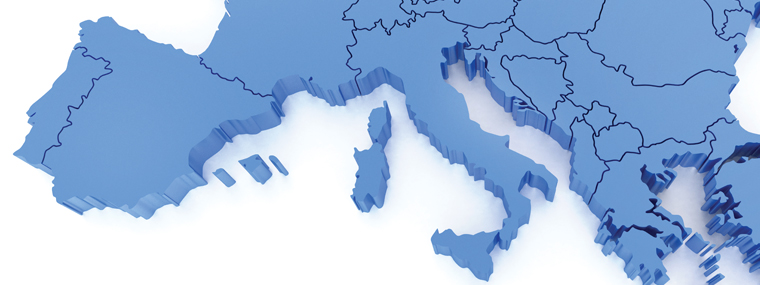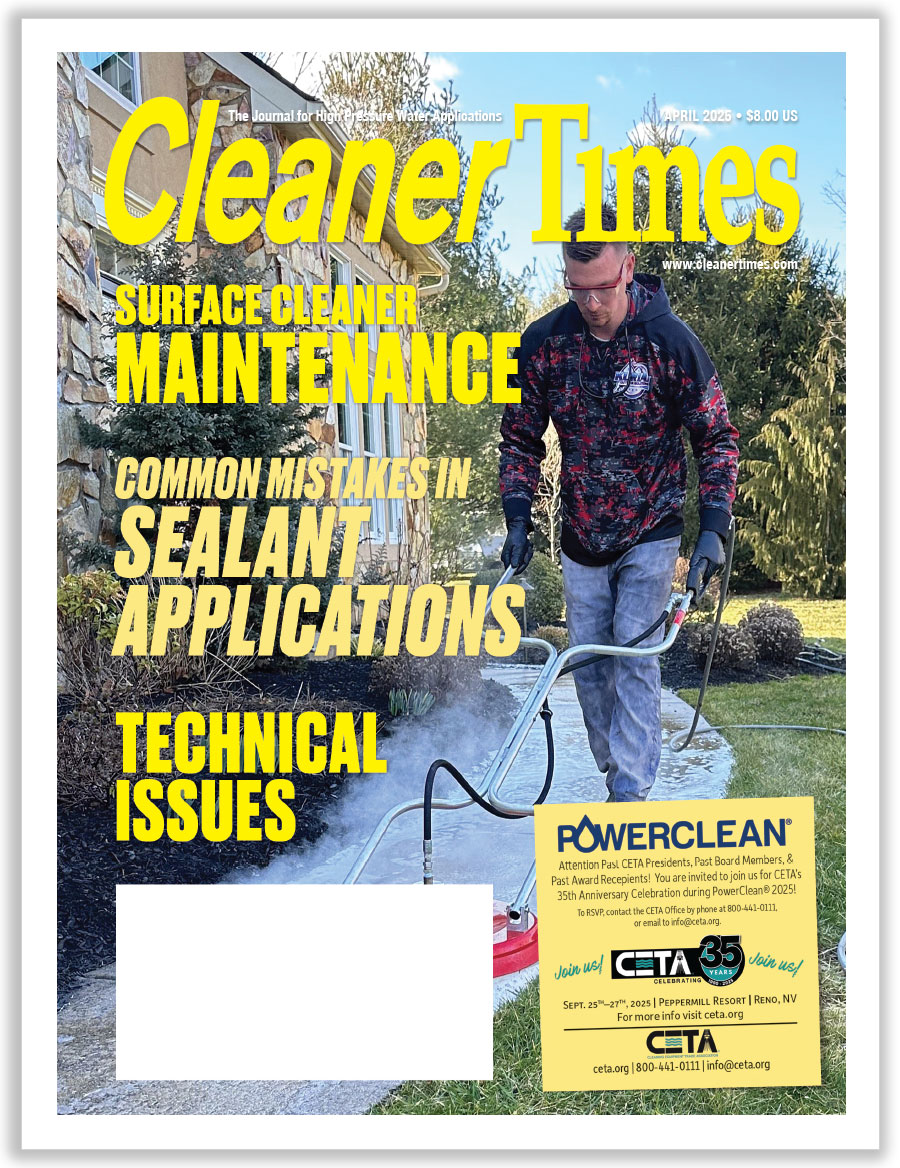
Growing Markets in Europe
Opportunity Is Where One Finds It
By Diane M. Calabrese / Published February 2017

Opportunity is where one finds it. A strong local or regional customer base puts a company on a strong foundation. But markets for products, including pressure washers and ancillaries, are global—a concept our industry em-braced some time ago.
A great number of manufacturers and distributors already have a business plan that includes national sales, sales across the continent of North America, and beyond. Expanding sales territories globally requires a good bit of investment of time and money because complying with rules established by foreign entities (nations or nation groups such as the European Union) is the first order of business.
Let’s consider the continent of Europe. As of December 2016, 28 countries in Europe belong to the EU, with one of them, the United Kingdom, in the process of exiting the EU. Five more countries (Macedonia, Monte-negro, Serbia, Turkey, and Albania) are candidates to join the EU.
Established in 1993, the EU aims to integrate economies (facilitate trade, for one) and politics (e.g., approaches to environmental issues and immigration). The European Economic Area (EA) refers to countries belonging
geographically to the continent of Europe whether they are EU members or not. If you combine the U.S. and EU economies, the sum accounts for approximately half of world GDP.
Despite the ease of communicating, making a sale to a customer somewhere in Europe is not as simple as taking an order via the Internet and shipping a product. The seller must understand the EU customs classification and tariffs system, as well as EU product safety and marking, labeling, and packaging requirements. And that’s just the start. The foregoing is not intended to discourage. It is only to inform.
Firsthand knowledge is incredibly valuable. Here, some industry experts share their observations about what a manufacturer or distributor must take into account when looking to grow in Europe.
“There are several differences between selling in Europe versus North America,” says David Sholson, international sales manager of Nilfisk Pressure Pro LLC in Fort Pierce, FL. “First of all, the customers are different and require a different type of service.”
The way customers must be served begins with the way they buy. “In the United States, most products are purchased from a traditional pressure washer distributor,” says Sholson. “In Europe, that is not the case.”
In addition to the uniqueness in how sales are made, there are differences in configuration of equipment. “In Europe, the vast majority of the products are electrically powered,” explains Sholson. “Their standard voltage allows for higher output.”
It’s not just the reliability of the electric power source but also the high price of petroleum products (gasoline, diesel) that contributes to a European preference for electrically-powered machines, explains Sholson.
On any short list of differences a U.S.-based seller might encounter in Europe, documentation of safety must be entered. “Safety is very important,” says Sholson. “The proper certifications are necessary in order to sell in the European market.”
Assess and Respond
“Europe tends to have stricter regulations, be it for water reclaiming, work conditions, or toxic substances in our products,” says Stefania Benetti, sales manager at P.A., SpA in Rubiera, Italy (Reggio Emilia province). “We need a lot more certifications for Europe, in terms of safety devices, limitations of pressure, and traceability of all materials used in our production. Some of our items are ATEX-certified, which means they can be used in a potentially explosive environment.”
A quick refresher about ATEX: It applies to electrical equipment that may be used in hazardous environments. The European Directive (2014/34/EU) from which it derives has the goal of ensuring safeguards on equipment, safeguards that prevent the equipment from becoming an ignition source.
Bottom line: To sell equipment in the EU, products must comply with the ATEX directive. Everyone welcomes the highest standards in safety and in environmental protection. To meet standards, companies may actually have more need for products.
“Our European customers are ready to spend more on components, as they have to comply with the regulations across the whole machine,” says Benetti. Meeting the requirements of customers also helps foster implementation of creative ideas.
In that creativity, Benetti sees a parallel with manufacturers and distributors in North America. “Both markets are highly receptive to innovation, and tend to embrace new items and developments in the production of equipment and components, especially if it brings significant reduction in time or workforce.”
There’s another similarity between markets in North America and Europe. “Contrary to developing markets, Europe and North America have very high labor costs, and anything that will bring down these costs is sought after and appreciated,” explains Benetti.
Being a match for the market is always the place to begin when contemplating expansion into a new region, irrespective of where it is. “Obviously, you need to adapt your products for the European market you intend to enter,” says Benetti. “Oil and gas mainly concerns Norway and Scotland, while Scandinavia is very big on food plants and pharmaceuticals.”
Consider the more specialized possibilities, too. “Niche markets are growing, like sewer cleaning,” says Benetti. She cautions, though, that “pipes in Europe tend to be much older and run down.”
An appraisal of how a product will be used is always necessary. “My advice is to know your market and get ready to respond to different needs in different places,” says Benetti.
Moreover, there’s a corollary to that appraisal, explains Benetti. Be sure if a sector or application is specific to Europe, that it’s thoroughly understood before aiming
to serve it.
Listen and Learn
Raymond Little, vice president of A.R. North America Inc. in Fridley, MN, has been with the company for 34 years. He spent the first 24 years of that tenure in Italy. He advises openness to different perspectives.
“An important matter is that of the culture of the country you want to try to sell into,” says Little. “The people you are trying to sell to, more likely than not, don’t want to hear that they should be doing things in a different way than what they have been doing for decades.”
If not immersion in another culture, a commitment to becoming acquainted with views of others is a key component of selling. The more one listens and learns, the more one appreciates differences and sees similarities.
“I would say that the one great similarity between serving customers in Europe and in North America today is that the main fundamentals are the same,” explains Little. That means both cohorts want “quality products at a competitive price, backed up with great customer service.”
One difference in the European market can be an advantage to U.S. sellers. “When presenting new products, in Europe you can show one year before the products are actually available, whilst in North America the products must be readily available or at least in transit.”
Selling in Europe requires being realistic about how the opportunities align with the factors governing sales—not just regulations, but also currency changes. “The price competitiveness of a given product built anywhere in the world is heavily reliant on currency exchange-rate fluctuations,” says Little. “Since these are very volatile today, you need to focus more on the unique product features of your units rather than your selling price.”
The perception of selling price may change. “It may be very attractive today but no longer so in six months’ time,” says Little.
Things change in other ways, too. Take the preponderance of electric pressure washers in Europe. “Gas units are starting to pick up,” says Little.
In the uptick in choice of gas units, there is an opening for manufacturers. “The North American manufacturers’ experience and expertise in building gas units needs to be exploited in pushing this opportunity to its full potential,” says Little.
Before You Go…
Travelers benefit from reading before trekking. Manufacturers and distributors can replicate the read-then-go experience. (And so, too, can contractors selling services —another opportunity in Europe, if only as a consultant.)
Export.gov offers a primer titled “Selling US Goods and Services in the EU” (2016.export.gov/europeanunion/marketresearch/sellingusproductsandservicesintheeu/index.asp). Much of what a reader learns will prevent false expectations. For one, Europe has a “late payment culture” that the EU has been trying to combat. Be cautious when signing contracts. If a contract falls under an individual country’s law instead of under an EU directive, it may be difficult to take action against late payment.
An EU directive and member state dichotomy also exists in other areas. While the EU sets minimum rates on VAT, the consumption tax applied to most goods and services, a member state has discretion to reduce rates as well as increase them. Tariffs, too, may vary with the member state.
“EU and the United States” (ec.europa.eu/trade/policy/countries-and-regions/countries/united-states/) is a primer produced by the EU for various trading partners. The specific link cited applies to the United States.
Finally, for market evaluation, the International Trade Administration (ITA) is an excellent resource. ITA (www.export.gov/ITA) helps U.S. companies prepare to export goods and services and also engages in enforcement and compliance.





